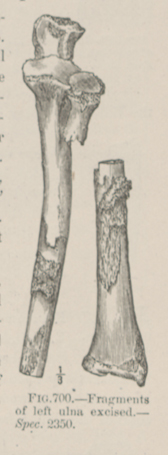Title: Wilcox, G. W.
Source text: The Medical and Surgical History of the War of the Rebellion. (1861-65.), Part 2, Volume 2 (Washington, DC: Government Printing Office, 1876), 959.
Civil War Washington ID: med.d2e30974
TEI/XML: med.d2e30974.xml
CASE 1915.—Private G. W. Wilcox, Co. I, 57th Massachusetts, aged 25 years, was wounded at Spottsylvania, May 19, 1864, and sent to Emory Hospital, Washington, where Surgeon N. R. Moseley, U. S. V., reported: "Admitted May 22, 1864, from the field. Gunshot wound of left forearm. A minié ball passed from without inward through middle third, lacerating the flesh and fracturing the radius at middle third. On May 23d, Acting Assistant Surgeon W. H. Ensign excised the radius at middle third, chloroform and ether being used as anæsthetics. At the time of the operation the limb was swollen, but the constitutional state of the patient was favorable. Splints and bandages were applied to the limb and cold-water dressings to the wound. On May 31st, erysipelatous inflammation set in with a tendency to gangrene. After the occurrence of erysipelas, carron oil and a solution of sulphate of copper were used externally, and stimulants and anodynes were administered internally. The patient died June 11, 1864, of pyæmia." The specimen, represented in the adjoining wood-cut (FIG. 700), was "contributed to the Museum by Dr. Moseley. It is described as "fragments, representing about one inch of the shaft of the radius, removed by operation."
